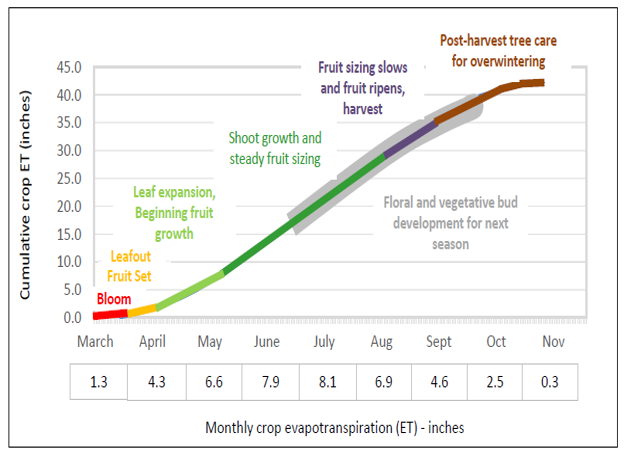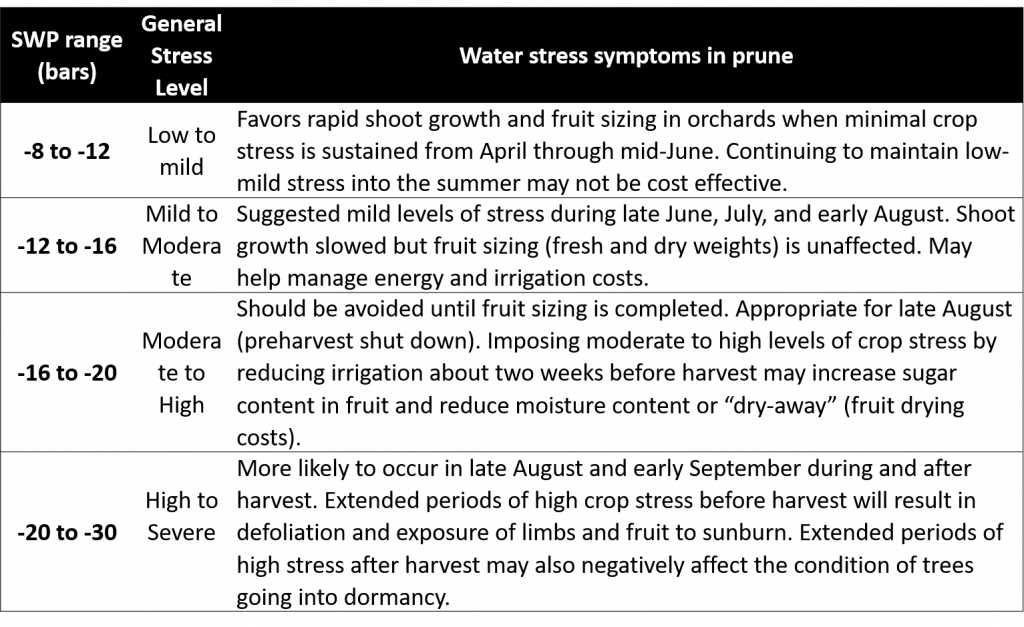Luke Milliron, UCCE Orchards Advisor, Butte, Glenn, and Tehama Counties
Franz Niederholzer, UCCE Farm Advisor; Colusa and Sutter/Yuba Counties
Allan Fulton, UCCE Irrigation and Water Resources Farm Advisor Emeritus
Richard Buchner, UCCE Farm Advisor Emeritus
Irrigation decisions leading up to and following prune harvest not only impact this year, but the harvests and orchard health in the years to come. Shoot growth has been in decline since early June, fresh fruit size increase slows by the end of July, while fruit dry weight increases until fruit reach physiological maturity (4 lbs pressure). Floral and vegetative bud development, for next year’s crop is also occurring, beginning in June and July on the current-season’s growth, see Figure 1. Average monthly evapotranspiration (ET) and the gradual seasonal ET accumulation are also given in the figure.

Figure 1. Graphic timeline of prune tree and crop development phases and associated average monthly and cumulative crop evapotranspiration (ET).
Like other crops, prune has varying susceptibility to water stress at different crop development stages. Deficit irrigation or supplying the trees with less than full ET (Figure 1), can offer key benefits beyond water savings and reduced pumping cots. To avoid excessive vegetative growth and associated pruning costs, maintaining a mild to moderate tree water stress from late June, through early August reduces shoot growth without slowing fruit sizing (Table 1). Once fruit have reached physiological maturity (4 lbs fruit pressure), a moderate to high stress achieved by cutting off irrigation in the week or two before harvest can improve dry-away ratios, reduce premature fruit drop, and decrease shaker bark injury at harvest. Post-harvest irrigation should recover the trees to mild- to moderate-stress in-order to not reduce photosynthesis and disrupt carbohydrate allocation to storage leading into overwintering. Care must be taken with any irrigation reductions. Sustaining high to severe water stress during the pre- and post-harvest period can reduce potassium uptake, encourage sunburn and growth of Cytospora cankers, and result in smaller fruit buds the following year.
Irrigation Management Approaches:
Although ET calculations or soil moisture monitoring can be used to manage irrigation surrounding harvest, they do not directly measure the water status of the tree. Conversely, pressure chamber stem water potential (SWP) readings do directly measure tree water status and can be used to help deliver the beneficial stress timings and avoid unwanted severe stress. SWP readings of -12 to -16 bars from late June up to the preharvest irrigation cut-off and again after harvest, achieve the desired mild to moderate stress level without harm to the orchard (Table 1). Cutting off irrigation in the week or two before harvest to achieve -16 to -20 bars SWP, delivers the desired moderate to high stress that helps reduce dry away and trunk damage (“barking”) at harvest. Finally, triggering irrigations according to SWP readings allows you to avoid unwanted crop stress levels, especially below -20 bars. To learn more about using and interpreting pressure chamber SWP readings, see our Stem Water Potential Manual Series.

Table 1. SWP levels in prune, consideration of how SWP might compare to baseline values under various weather conditions, and the corresponding water stress symptoms to expect.


Leave a Reply